-
History of:
- Resources about:
- More:
- Baby walkers
- Bakehouses
- Bed warmers
- Beer, ale mullers
- Besoms, broom-making
- Box, cabinet, and press beds
- Butter crocks, coolers
- Candle snuffers, tallow
- Clothes horses, airers
- Cooking on a peat fire
- Drying grounds
- Enamel cookware
- Fireplaces
- Irons for frills & ruffles
- Knitting sheaths, belts
- Laundry starch
- Log cabin beds
- Lye and chamber-lye
- Mangles
- Marseilles quilts
- Medieval beds
- Rag rugs
- Rushlights, dips & nips
- Straw mattresses
- Sugar cutters - nips & tongs
- Tablecloths
- Tinderboxes
- Washing bats and beetles
- Washing dollies
- List of all articles
Subscribe to RSS feed or get email updates.
The Infant is wrapped in Swadling-clothes, is laid in a Cradle, is suckled by the Mother with her breasts, and fed with Pap. Afterwards it learneth to go by a Standing-stool, playeth with Rattles, & beginneth to speak.
Comenius, Orbis sensualium pictus, 1654, translated by Charles Hoole, 1659
...young children, who are tied in Go-carts, to keep their steps from sliding...
Matthew Prior, An Epistle to Fleetwood Shephard Esq., 1689
(in Hazlitt's Select Poets, 1825)
When your child is five months old, provided you follow my directions, you may put it into a go-cart...after it is in, tie the cart to the leg of a table or a chair; continue it thus for a fortnight, that it may feel its feet properly...I have [had] one made with a flag to it, to encourage the child to stand upright...
Sarah Brown, A letter to a lady on the Mode of conducting herself during pregnancy - also on the management of the infant, 1777
There's my friend Lady C—; in an elegant undress she passes for very genteel, but put her into a hoop and she looks as pitiable a figure, as much a prisoner, and as little able to walk, as a child in a go-cart. She gets on, I grant you, and so does the poor child; but, getting on, you know, is not walking.
Maria Edgeworth, Belinda, 1801
Baby walkers & standing stools...
...baby runners, go-carts, going-carts, baby cages, walking stools, crawling chairs, & baby-trots...
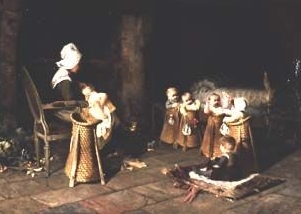 Does a baby walker help a child learn to walk? Or does it just hold it safely while
its carer is occupied with something else? Some, like the 14th century walker in
a church embroidery (below left), are clearly intended for walking practice. Others,
like the French basket "standing stools" in a 19th century painting (right), seem
to be more for adult convenience. Though similar un-wheeled
wicker walkers can help babies get around, those in the picture seem to
be rather restrictive. (No apologies for discussing baby walkers on a website about
housekeeping, since they have so often been useful to busy women who cook and do
laundry.)
Does a baby walker help a child learn to walk? Or does it just hold it safely while
its carer is occupied with something else? Some, like the 14th century walker in
a church embroidery (below left), are clearly intended for walking practice. Others,
like the French basket "standing stools" in a 19th century painting (right), seem
to be more for adult convenience. Though similar un-wheeled
wicker walkers can help babies get around, those in the picture seem to
be rather restrictive. (No apologies for discussing baby walkers on a website about
housekeeping, since they have so often been useful to busy women who cook and do
laundry.)
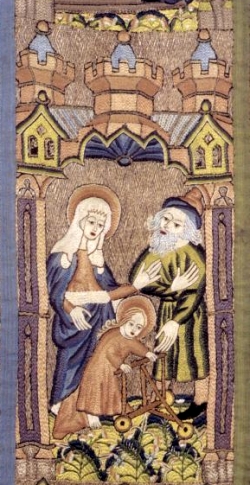 Baby walkers appear in various 14th and 15th century works of art, including the
Book of Hours of Catherine of Cleves. The 16th century medical writer Ferrarius
recommended them for training an infant to walk. In the 17th century they were taken
as a symbol of mastering a skill through constant exercise. And the idea of encouraging a child to be upright, both physically
and morally, appealed to some.
Baby walkers appear in various 14th and 15th century works of art, including the
Book of Hours of Catherine of Cleves. The 16th century medical writer Ferrarius
recommended them for training an infant to walk. In the 17th century they were taken
as a symbol of mastering a skill through constant exercise. And the idea of encouraging a child to be upright, both physically
and morally, appealed to some.
In his work of 1577, Ferrarius advocated the use of a wooden walker.....This was both a learning and an exercising device; in some situations it prevented the child from touching a hot stove or fireplace. Ferrarius illustrated a metal form to be worn on the child's head while using the walker, for protection in the event of a fall.
Mary Spaulding and Penny Welch, Nurturing Yesterday's Child, 1991, referring to Omnibonus Ferrarius, whose De arte medica infantium was first published in northern Italy.
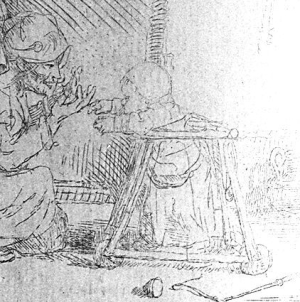 The round or
square frame on wheels is
perhaps the most familiar style of baby walker. Not only are there plenty on sale
today, but many centuries-old
wooden ones survive in historic houses and museums. Rembrandt drew one around
1646 (right) in an etching sometimes referred to as "The Walking Trainer" or "The
Go-Cart".
The round or
square frame on wheels is
perhaps the most familiar style of baby walker. Not only are there plenty on sale
today, but many centuries-old
wooden ones survive in historic houses and museums. Rembrandt drew one around
1646 (right) in an etching sometimes referred to as "The Walking Trainer" or "The
Go-Cart".
Go-cart was a common name for walkers. (See left-hand column) Standing stools, probably without wheels, and walking stools were both possible. Other names included baby-cage, going-cart, or baby-trot. The name baby walker is first recorded in 19th century America, though New England had known such things since the 17th century. In the 1870s, the enthusiasm for patenting "inventions" in the US led to many patents claiming improvements in baby walkers and walker/chair combinations (See 1875 patent drawing lower down the page and the 1928 Chicago hospital walkers illustrated below right).
....a baby-walker, the combination herein described of the hinged legs A, top piece B, B having grooves i, and hinged rockers D, having Casters E, whereby it can be converted into a supporting-frame for a cradle.....
Patent claim filed in 1875 by Jens Erikson of Madison, Wisconsin. Patent issued 1876
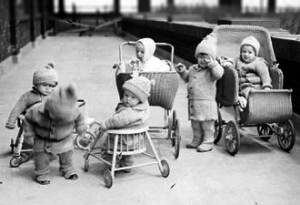 There used to be two further kinds
of "walker" or frame designed to keep a child away from danger and standing upright,
while also allowing them some exercise. One is a
rectangular frame with a
sliding support for the baby who could move along in a straight line,
first one way, then the other.
There used to be two further kinds
of "walker" or frame designed to keep a child away from danger and standing upright,
while also allowing them some exercise. One is a
rectangular frame with a
sliding support for the baby who could move along in a straight line,
first one way, then the other.
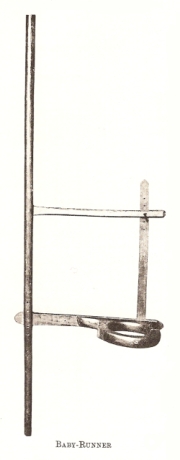 The other design is the baby runner (left). This was described a hundred years ago:
The other design is the baby runner (left). This was described a hundred years ago:
When the baby had grown beyond the crawling stage, it was exercised and encouraged to find its feet, and at the same time kept safe from the fire, by the baby-runner. The upright rod fitted at the bottom into a hole in the floor, and at the top into the beam.....The child was put into the wooden ring, and the rack was arranged to suit its height. The child could move about in as much of a circle as the position of the contrivance would allow.
Gertrude Jekyll, Old West Surrey, 1904
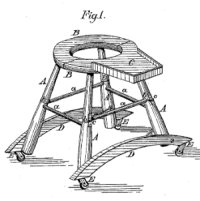 Unlike the other kinds of walker, known in many European countries, the baby runner
may belong to England alone. It is hard to track, since it was fitted into the timbers
of the house, and many examples must have disappeared when buildings were renovated
or demolished. Edward Pinto's
Treen: an encyclopaedia
Unlike the other kinds of walker, known in many European countries, the baby runner
may belong to England alone. It is hard to track, since it was fitted into the timbers
of the house, and many examples must have disappeared when buildings were renovated
or demolished. Edward Pinto's
Treen: an encyclopaedia
has a picture of one from the 17th century and says the ring was often padded with
leather or cloth upholstery.
But when his Limbs begin to grow strong and nervous, from the Use of some good and substantial Diet, it will be Time to make him begin to go alone. Then his Nurse ought to support him by his Leading-Strings, 'till he is able to put his Feet upon the Ground, and rest himself upon them. In short, in order to accustom him to go alone, he should be shut up in a little Go-Cart, or Go-Wain, which will roll him on as he goes, without any Danger of falling; and most Children are wonderfully pleas'd and delighted with this Kind of Exercise.
Anononymous, The art of nursing: or, the method of bringing up young children according to the rules of physick, London 1733
Can you find the baby walker in this
1505 painting by Hieronymus Bosch? (Clue: look on the
right edge of the triptych.)
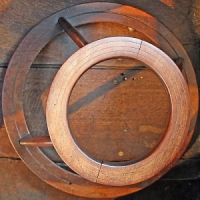
 16 January 2008
16 January 2008
You may like our new sister site Home Things Past where you'll find articles about antiques, vintage kitchen stuff, crafts, and other things to do with home life in the past. There's space for comments and discussion too. Please do take a look and add your thoughts. (Comments don't appear instantly.)
For sources please refer to the books page, and/or the excerpts quoted on the pages of this website, and note that many links lead to museum sites. Feel free to ask if you're looking for a specific reference - feedback is always welcome anyway. Unfortunately, it's not possible to help you with queries about prices or valuation.


